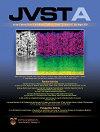W1−xTaxN6、W1−xMoxN6和Mo1−xTaxN6(0≤x≤1)六方结构合金力学和电子性能的密度泛函理论计算
IF 2.1
3区 材料科学
Q3 MATERIALS SCIENCE, COATINGS & FILMS
引用次数: 0
摘要
在这项研究中,我们报告了W1−xTaxN6、W1−xMoxN6和Mo1−xTaxN6(0≤x≤1)合金在六角形结构(空间群:R3¯m)中的结构、能量、力学、电子、热学和磁性。这些化合物在机械上是稳定的,而W0.33Ta0.66N6在振动上是不稳定的。在力学稳定和振动稳定的化合物中,W0.66Ta0.33N6和W0.66Mo0.33N6的硬度最高,为55 GPa,而最软的合金(Mo0.33Ta0.66N6)的硬度为46 GPa,显示出新型超硬材料的潜力。这些材料的高硬度是由于六方环的共价N-N键和金属对氮电荷转移的共同作用。只有两种合金W0.33Mo0.66N6和W0.66Mo0.33N6是半导体合金,电子带隙分别为1.82和1.92 eV。W0.66Mo0.33N6的磁矩为0.82 μB /单位金属。本文章由计算机程序翻译,如有差异,请以英文原文为准。
Density functional theory calculations of mechanical and electronic properties of W1−xTaxN6, W1−xMoxN6, and Mo1−xTaxN6 (0 ≤ x ≤ 1) alloys in a hexagonal structure
In this study, we report the structural, energetic, mechanical, electronic, thermal, and magnetic properties of W1−xTaxN6, W1−xMoxN6, and Mo1−xTaxN6 (0 ≤ x ≤ 1) alloys in a hexagonal structure (space group: R3¯m) determined using density functional theory–based first-principles calculations. These compounds are mechanically stable, whereas W0.33Ta0.66N6 is vibrationally unstable. Among both mechanically and vibrationally stable compounds, W0.66Ta0.33N6 and W0.66Mo0.33N6 have the highest hardness of 55 GPa, while the softest alloy (Mo0.33Ta0.66N6) exhibits 46 GPa, indicating new potential super hard materials. The high hardness in these materials is attributed to the combined effect of covalent N–N bonding of hexagonal rings and a metal to nitrogen charge transfer. Only two alloys, W0.33Mo0.66N6 and W0.66Mo0.33N6, are semiconducting alloys with electronic bandgaps of 1.82 and 1.92 eV, respectively. A significant magnetic moment of 0.82 μB per unit metal was calculated for W0.66Mo0.33N6.
求助全文
通过发布文献求助,成功后即可免费获取论文全文。
去求助
来源期刊

Journal of Vacuum Science & Technology A
工程技术-材料科学:膜
CiteScore
5.10
自引率
10.30%
发文量
247
审稿时长
2.1 months
期刊介绍:
Journal of Vacuum Science & Technology A publishes reports of original research, letters, and review articles that focus on fundamental scientific understanding of interfaces, surfaces, plasmas and thin films and on using this understanding to advance the state-of-the-art in various technological applications.
 求助内容:
求助内容: 应助结果提醒方式:
应助结果提醒方式:


